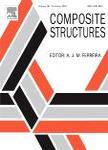版权所有:内蒙古大学图书馆 技术提供:维普资讯• 智图
内蒙古自治区呼和浩特市赛罕区大学西街235号 邮编: 010021

作者机构:Southern Univ Sci & Technol Dept Ocean Sci & Engn Shenzhen 518055 Peoples R China Southeast Univ Sch Civil Engn Nanjing 210096 Peoples R China Jinan Univ MOE Key Lab Disaster Forecast & Control Engn Guangzhou 510632 Peoples R China
出 版 物:《COMPOSITE STRUCTURES》 (复合材料结构)
年 卷 期:2021年第272卷
页 面:114220-114220页
核心收录:
学科分类:08[工学] 0805[工学-材料科学与工程(可授工学、理学学位)] 080502[工学-材料学] 0801[工学-力学(可授工学、理学学位)]
基 金:National Natural Science Foundation of China China Postdoctoral Science Foundation [2019M651655] Open Research Fund Program of Ministry of Education Key Lab of Disaster Forecast and Control in Engineering of the People's Republic of China
主 题:Adhesively bonded joint Shear-lag model Interfacial stress transfer Triangular pulse loading Harmonic loading Analytical solution
摘 要:The constitutive law of the interface is a prime issue when evaluating the strength of adhesively bonded joints. The polymer-based adhesives exhibit loading rate sensitivity and damping properties owing to their viscous nature, especially at high temperatures or under water. This paper aims to establish a shear-lag model to elucidate the mechanical behaviour of adhesively bonded joints under triangular pulse loading and harmonic loading. The extended shear-lag model is focused on improving the previous shear-lag models by including viscoelastic behaviour using the Kelvin model for the adhesive. Analytical expressions of the slip and interfacial shear stress distribution have been respectively presented for pull-push joint and pull-pull joint under triangular pulse loading. Compared with finite element simulation, the predictive model shows an excellent agreement with the FEA results. The damping properties including the storage modulus, loss modulus and loss factor for these two bonded joints subjected to harmonic loading are theoretically derived. Finally, results obtained from the predictive model are presented to illustrate how the bond length, loading rate and loading frequency affect the behaviour of such bonded joints.